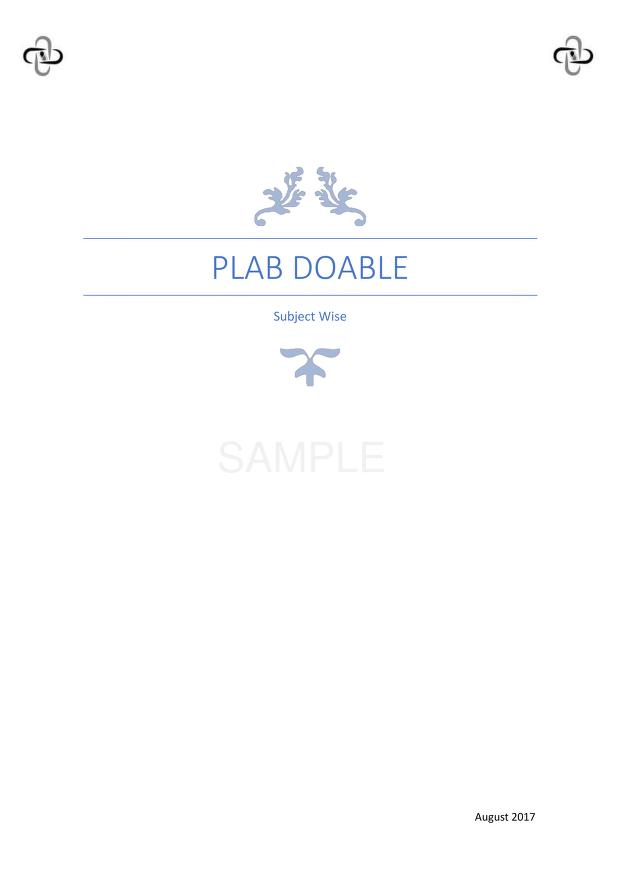Subjectwise Topics to cover for PLAB 1
Subjectwise Topics to cover for PLAB 1
These are the Subjectwise categorized Topics for PLAB which you should cover.
HAEMATOLOGY:
1. Abnormal blood film
a) Peripheral blood film (red cell, white cell and platelets)
b) Differential white cell count
c) Pancytopenia
d) Bone marrow failure
e) ESR
f) Hyperviscosity syndrome
g) Spleen and splenectomy
2. Haematological malignancies and myeloproliferative disorders
a) Leukaemia
b) Myeloma
c) Paraproteinemia
d) Amyloidosis
3. Bruising/ bleeding/ purpura
a) Intrinsic and extrinsic pathways (clotting)
b) Any cause including
c) Bleeding disorder
d) Anticoagulants
e) Thrombophilia
4. Immunosuppressive drugs
5. Inherited bleeding disorders Anaemia of any cause
a) Iron deficiency anaemia
b) Refractory anaemia
c) Anaemia of chronic disease
d) Sideroblastic anaemia
e) Macrocytic anaemia (all causes)
f) Pernicious anaemia
g) Haemolytic anaemia
h) Sickle cell anaemia
i) Thalassaemia anaemia
j) Transfusion (safety & procedures)
k) (Myeloproliferative disorders)
6. Generalised enlarged lymph nodes: any cause
BREAST LUMP AND/OR PAIN:
1. Cancer
2. Infection
a) abscess;
b) puerperal mastitis
3. Benign
a) fibro-adenoma;
b) fibro-adenosis;
c) fat necrosis; cysts)
4. Nipple
a) discharge;
b) inversion;
c) Paget’s
5. Request for reduction/augmentation
CARDIOVASCULAR:
1. Chest Pain
a) Acute myocardial infarction, acute coronary syndrome and angina
b) Acute myocardial infarction (MI)
c) Acute coronary syndrome (ACS)
d) Angina pectoris
e) Electrocardiogram (ECG) – normal and abnormal
f) Investigations (cardiac catheterisation; echocardiography; nuclear
cardiology; ECG: exercise/ ambulatory)
g) Complications of MI (arrhythmias; hypertension)
h) Atherosclerosis
2. Heart Murmur: any cause
3. Hypertension: all, including risk fator
4. Palpitations
a) Bradycardia
b) Narrow complex tachycardia
c) Atrial fibrillation and flutter
d) Broad complex tachycardia
e) Pacemakers
5. Peripheral arterial disease
a) Aneurisms
b) Ischaemic limb
c) Occlusions
6. Peripheral oedema and Heart failure including valvular heart disorder and
rheumatic heart disease
a) Rheumatic fever
b) Mitral valve disease
c) Aortic valve disease
d) Right heart valve disease
e) Indications for cardiac surgery
f) Infective endocarditis
g) Diseases of heart muscle including myocarditis
h) Pericardial disease
i) Dyspnoea in heart failure
7. Peripheral Venous problems
a) VTE
b) DVT
c) Risk Factors
d) Varicose Veins
DEVELOPMENTAL PROBLEMS:
1. Congenital Abnormalities
a) Ventricular septal defect
b) Atrial septal defect
c) Patent ductus arteriosus
d) Aortic stenosis
e) Pulmonary stenosis
f) Coarctation of the aorta
g) Fallot’s tetralogy
h) Transposition of the great arteries
i) Tricuspid atresia
j) Total anomalous pulmonary venous return
k) Persistent truncus arteriosus
l) Hypoplastic left heart
m) Pulmonary atresia
n) Ebstein’s anomaly
o) Polycystic kidneys
p) Congenital adrenal hyperplasia
q) Chromosomal abnormalities (including Turner’s; Down’s; Tay Sachs’)
r) Inherited conditions (cystic fibrosis; PKU)
s) Acquired conditions (including caused by drugs/alcohol)
t) Neural tube defects (including spina bifida)
u) Developmental abnormalities of the musculoskeletal system (including
talipes)
2. Developmental Delay/ Failure to thrive
a) Endocrine problems/ Metabolic disorders
b) Malabsorption (see also under Digestive)
c) Inadequate diet
3. Psychological and Social
a) Non-accidental injury
b) Sexual abuse
c) Emotional deprivation
d) Bullying
e) Manifestations of neglect
DIGESTIVE:
1. Abdominal Mass
a) Organomegaly
b) Hernias
c) Ascites
2. Abdominal Pain
a) Perforation
b) Obstruction
c) Ischaemia
d) Aneurysm (see also under Cardiovascular/ Peripheral arterial disease)
e) Inflammatory conditions (including diverticulitis; appendicitis, pancreatitis)
f) Colic: ureteric (see also under Renal), Biliary/ gallbladder (see also under
Jaundice)
3. Anorexia and weight loss
a) Cancer
b) Metabolic causes including diabetes (see under Endocrine/ Abnormal
blood sugar);
c) thyroid (see under Endocrine/ Thyroid abnormalities)
d) Malabsorption
e) Physical causes of anorexia
f) Psychological causes of anorexia (see also under Mental health/ Eating
problems
4. Facial Swelling
a) Cancer
b) Sinusitis
c) Salivary glands
d) Teeth
e) Oral cavity
f) Lymph nodes (see also under Blood and lymph)
5. Jaundice
a) Pre-hepatic (including haemolysis)
b) Hepatic (including drug-induced)
c) Post-hepatic (including biliary obstruction)
6. Lower GI Problems
a) Including faecal incontinence
b) Spurious diarrhoea and encopresis
c) Cancer
d) Ulceration
e) Bleeding
f) Abnormal anatomy (fissures, piles, prolapse)
g) Masses (including polyps)
h) Altered bowel habit (constipation, diarrhoea)
i) Rectal pain
j) Pruritis ani
k) Inflammation (including IBD)
7. Upper GI Problems
a) Including nausea and vomiting
b) Infections (including food poisoning, UTI, gastroenteritis)
c) Pyloric stenosis (see also under Developmental)
d) Drug-induced
e) Raised intracranial pressure
f) Pregnancy (see also under Reproductive)
g) Constipation
h) Cancer
i) Ulceration
j) GORD
k) Bleeding
l) Dysphagia (including tumours; benign; neurological causes; congenital;
acquired)
8. Nutrition
a) Recognises nutritional disorders are common in patients with long-term
conditions
b) Performs basic nutritional screen and recognises patients with potential for
nutritional deficiencies and considers this in planning care
c) Formulates a plan for investigation and management of weight loss or
weight gain
d) Demonstrates the knowledge, skills, attitudes and behaviours to assess
patients’ basic nutritional requirements
e) Recognises major nutritional abnormalities and eating disorders and
establishes a management plan, where relevant with other healthcare
professional input
f) Works with other healthcare professionals in addressing nutritional needs
and communicating these during care planning
g) Makes nutritional care part of daily practice
h) Considers the additional effects of long-term ill-health on nutritional status
and the effect of poor nutrition on long-term health.




Was unable to download 1000 extended matching emqs